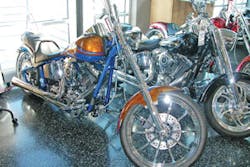Motorcycle Repair Offers Steady Opportunity
Anyone who watches the Discovery Channel on cable TV with regularity is no doubt familiar with the multiple shows highlighting work in motorcycle shops. Each week viewers tune in to watch feuding mechanics working against the odds and an improbable deadline with a new motorcycle that could redefine the industry. It’s good television.
Not terribly realistic, but one thing these shows highlight is a growing obsession and increasing popularity of custom motorcycles throughout the 18- to 24-year-old male population. A growth that is seeing a rise in small and specialized motorcycle repair shops across the country.
Training the mechanic
The complexity of motorcycles continues to advance. Within the next three years, motorcycles with carburetors will be a thing of the past, replaced by elaborate computer-monitored fuel-injection systems. In addition, the old two-stroke engines are being shelved in favor of more durable four-stroke versions.
As a result, dealers and shopkeepers are becoming hard-pressed to hire and retain mechanics that are trained in high-tech computerized equipment and capable of adapting to the rapid changes encroaching on the industry.
A typical motorcycle repair mechanic is highly specialized and well-trained. They’ve graduated from specialized small-engine training programs and have been involved in apprentice work and mentoring programs as they’ve worked through the early stages of their careers.
Younger mechanics at the start of their careers can expect a three- to five-year on-the-job training program just to become proficient in all aspects of the motorcycle. Even so, the amount of basic electronic and computer knowledge employers expect of the young mechanics they hire continues to rise.
Employers will need to send their mechanics to refresher training periodically to keep their shops up-to-date with the latest technology, from both a tool and a vehicle perspective. Such training may also be required by the manufacturers to perform warranty work. As the complexity of the technology on the bikes rise, the repair shop has to always be forward-thinking in terms of training.
Equipping the shop
Like their large-engine counterparts, motorcycles will need periodic service and inspections to keep them running at peak performance.
Not all motorcycles are built alike. A deep divide exists between two age-old adversaries; the metric system and the American (or English) system of measurement. Foreign bikes, such as Honda, are built largely using the metric system. Domestic brands, like Harley-Davidson, use the American standard system. While this may seem like a small dilemma to the outside observer, for the shop looking to purchase a wide variety of specialty tools and diagnostic equipment, it spells out taking sides, or rather specific brand names, and sticking with them.
Most motorcycle mechanics work for dealers and therefore usually only service the brand names the dealer sells. While smaller independent shops can be found across the country, they will usually only specialize in a few particular brand names; and even then usually will stick with either a metric or American focus. This tactic is aimed to create a loyal, select customer base. In order to maintain that base, it is critical that shops produce the work to match and therefore need the quality of tools and equipment to meet the experience and skills of the mechanics.
A typical repair shop will host a wide variety of tools. From the most common tools, such as screwdrivers, drills and wrenches, to high-tech computerized analysis machines, gauges, voltmeters and engine diagnostic equipment, the average shop is equipped to repair any problem in the minimum amount of time.
Repair shops will purchase tools from a wide variety of sources. Mobile tool dealers are a traditionally large and reliable source for many dealers. Specialty tools from manufacturers rank a close second, with the local hardware store bringing up a distant third.
Mechanics have very little patience for unreliable or substandard equipment. Their reputation is on the line every time they touch a bike, and as with all specialized industries, reputation is everything.
Because most motorcycle riders covet their bikes, repair shops must take extra care in ensuring the highest quality work in a reasonable amount of time. As a result, most shops will invest thousands of dollars on the latest and greatest equipment from the smallest crescent wrench to the largest computerized engine diagnostic machine. They will also continue to invest money to keep the shop stocked with the best equipment.
Industry outlook
As one can expect, most motorcycle repair shops across the country experience seasonal peaks and valleys. In northern territories, winter months are typically slow with most mechanics working less than 40 hours a week. Spring and summer months will bring a considerable surge in business and mechanics are commonly seen working in excess of 40 hours.
Shops in colder climates will often hire mechanics for seasonal work only, or expand their services to include other small engine work, such as snowmobiles, to pick up slack during the slower periods.
In southern states, repair shops experience steady work as seasonal riding is less of a factor, and warmer temperatures allow for northern snowbirds seeking winter refuge a place to bring their bikes.
The motorcycle industry continues to grow at a steady rate. According to the Motorcycle Industry Council (www.mic.org), motorcycle sales projections are expected to remain strong over the next decade.
According to MIC, motorcycle usage will continue to be strong with the historically large proportion of enthusiasts, the 18- to 24-year-old males.
Recent years have also shown that a large number of the over-40 crowd has been purchasing motorcycles at increasing rates. This group tends to have more disposable income to spend on this type of equipment.
Industry analysts feel that as more people enter this age group over the next 10 years, the motorcycle industry, as well as other recreational vehicle industries, can expect to see an expansion in the marketplace. This increase can only mean a higher demand for qualified motorcycle mechanics, and thus, a higher demand for the right tools.
